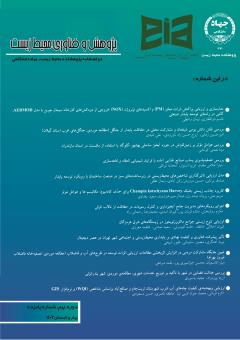ارزیابی تنوع زیستی جوامع ماکروزئوبنتوز در زیستگاههای شرق هرمزگان
محورهای موضوعی : Animal environment
کیوان اجلالی خانقاه
1
![]() ,
حامد کیومرثی
2
,
حامد کیومرثی
2
![]() ,
سعید تمدنی
3
,
سعید تمدنی
3
![]() ,
فاطمه معززی
4
,
فاطمه معززی
4
![]()
1 - استادیار پژوهشکده اکولوژی خلیجفارس و دریای عمان، موسسۀ تحقیقات علوم شیلاتی کشور، سازمان تحقیقات آموزش و ترویج کشاورزی، بندرعباس، ایران.
2 - بخش تحقیقات علوم دامی، مرکز تحقیقات و آموزش کشاورزی و منابع طبیعی استان گیلان، سازمان تحقیقات، آموزش و ترویج کشاورزی، رشت، ایران
3 - پژوهشکده اکولوژی خلیجفارس و دریای عمان، موسسۀ تحقیقات علوم شیلاتی کشور، سازمان تحقیقات آموزش و ترویج کشاورزی، بندرعباس، ایران.
4 - بخش تحقیقات اقتصادی، اجتماعی و ترویج کشاورزی، مرکز تحقیقات و آموزش کشاورزی و منابع طبیعی استان گیلان، سازمان تحقیقات، آموزش و ترویج کشاورزی، رشت، ایران
کلید واژه: ماکروزئوبنتوز, تنوع زیستی, اکولوژی, هرمزگان,
چکیده مقاله :
این مطالعه به منظور بررسی تغییرات تنوع زیستی اجتماعات ماکروبنتوزها در سالهای 1386، 1388، 1397 و 1398 صورت گرفت. نمونهبرداری از زسوبات بستر در 9 ایستگاه از مرکز تا غرب سواحل بندرعباس بوسیله یک دستگاه گرب ون وین انجام شد. در این بررسی 16 گروه اصلی شامل پرتاران، آمفیپودا، شکمپایان و دوکفهایها، سیپونکولا، ناوپایان، فرامینیفرا، استراکودا، تانایداسه،کوماسه، دکاپودا، اکیورا، کرمهای نواری، اوفازیاسه، میسیداسه، مارسانان و تعدادی گروه فرعی (از نظر تعداد) مانند اسفنجها، کیسهتنان ،لارو ماهیان، تونیکاتا، همیکورداتا و برخی دیگر از بیمهرگان مورد شناسایی قرار گرفتند. پرتاران با 57 درصد و به دنبال آنها آمفیپودا با 18 درصد شکمپایان دوکفهایها و سیپونکلا هر کدام با 4 درصد ناوپایان با 3 درصد فرامینیفرا، استراکودا، تانایداسه، اکیوراها، هر کدام با 2 درصد و کوماسه، دکاپودا کرمهای نواری، اوفازیاسه، میسیداسه و مارسانان با فراوانی نسبی 1 درصد ساختار جوامع بنتیک را تشکیل میدادند. همچنین تعداد 347 جنس و گونه متعلق به 11 شاخه از بیمهرگان دریایی (ماکروبنتوز) مورد شناسایی قرار گرفتند. بجز در سال 1397که گروه تانایداسه گروه غالب را تشکیل میداد در سایر موارد پرتاران گروه غالب را تشکیل میدادند. شاخصهای تنوع زیستی بررسی شده در خلال سالهای مذکور نشان داد که در سالهای 1386، 1388 و سال 1397 ایستگاههای مورد مطالعه در شرایط عاری از استرس بودند ولی در سال 1398 ایستگاه 3 در شرایط استرس شدید و سایر ایستگاهها در شرایط استرس متوسط قرار داشتند. به عبارت دیگر بعد از گذشت 10 سال تنوع زیستی کاهش پیدا نموده است.
This study was conducted to investigate the changes in the biodiversity of macrobenthos communities in 2016, 2018, 2017 and 2018. Sampling of bed sediments substrates was carried out in 9 stations from the center to the west of the Bandar Abbas coast by a grab van veen device. In this study, 16 main groups including polychaeta, amphipoda, gastropods and bivalves, sipuncula, copepoda, foraminifera, ostracoda, Tanaidacea, Comacea, Decapoda, Echiora, tapeworms, Euphausiacea, Mysidacea, ophiuridea and a number of subgroups (in terms of number) such as Porifera, Cniderians, fish larvae, Tunicata, Hemicordata and some other invertebrates were identified. Pretaran with 57%, followed by Amphipoda with 18%, gastropods, bivalves and sipunclea, each with 4%, navipods with 3%, Foraminifera, Ostracoda, Tanidaceae, Equira, each with 2% and Comaceae, Decapoda, tapeworms, Ophasiacea, Mysidaceae and Marsans with a relative abundance of 1% formed the structure of benthic communities. Additionally, a total of 347 genera and species belonging to 11 phyla of marine invertebrates (macrobenthos) were identified. Except for in 2018, when the tanaidaceans group dominated, in other instances, polychaeta created the dominant group. Biodiversity indicators studied during the mentioned years showed that in 2016, 2018 and 2018, the studied stations were in stress-free conditions; but in 2018, station 3 was under severe stress and other stations were under moderate stress. However, in 2019, station 3 was under severe stress conditions other stations were under moderate stress. In other words, after 10 years, biodiversity has decreased in the studied stations.


